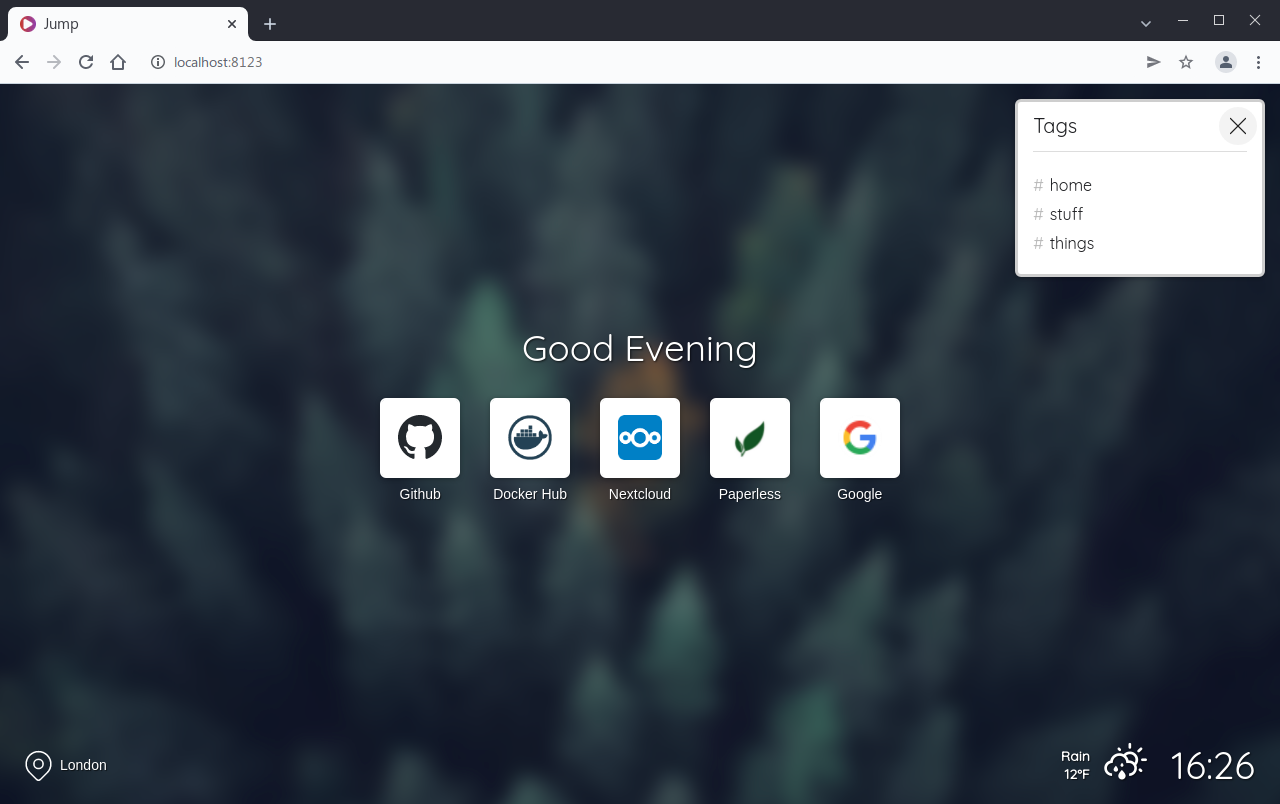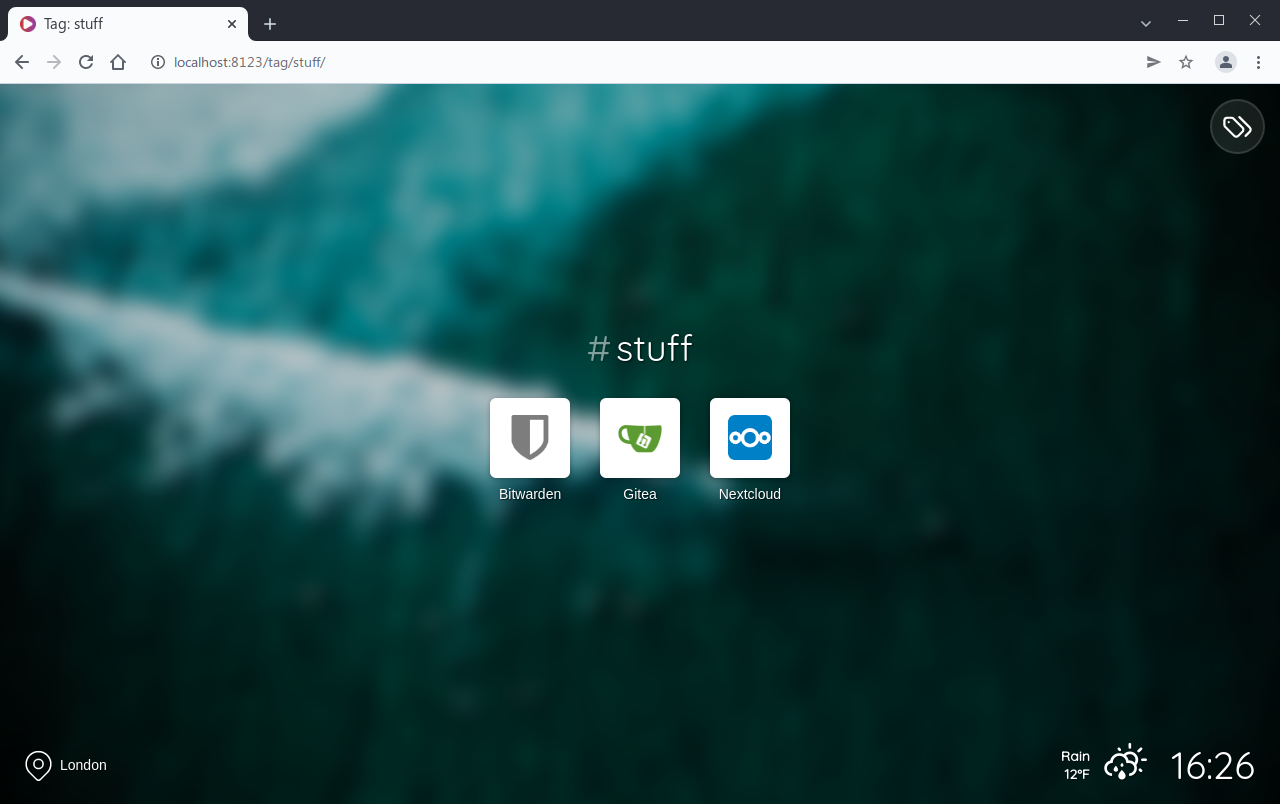Jump is yet another self-hosted startpage for your server designed to be simple, stylish, fast and secure.
- Fast, easy to deploy, secure
- Custom sites and icons
- Categorise sites with tags
- Fetch favicons for sites without custom icons
- Custom background images
- Open Weather Map integration
Get the container image from Docker Hub (https://hub.docker.com/r/daledavies/jump).
The following will start Jump and serve the page at http://localhost:8123 with a custom site name, Open Weather Map support, and volumes to map Jump's "backgrounds" and "sites" directories to local directories on your machine...
version: '3'
services:
web:
image: daledavies/jump
ports:
- 8123:8080
volumes:
- ./backgrounds:/backgrounds
- ./sites:/sites
environment:
SITENAME: 'Custom site name'
OWMAPIKEY: '0a1b2c3d4e5f6a7b8c9d0a1b'
LATLONG: '51.509865,-0.118092'
You can use the following optional environment variables to configure/customise your Jump site...
SITENAME- Custom site name.SHOWCLOCK: 'true'- Show/hide the clock.AMPMCLOCK: 'true'- Show 12 hour clock format if true.SHOWGREETING: 'true'- Show a friendly greeting message rather than "#home".BGBLUR: 70- Background image blur percentage.BGBRIGHT: 85- Background image brightness percentage.NOINDEX: 'true'- Include a robots noindex meta tag in site headerCACHEBYPASS: 'true'- Bypass all caches, useful for testing changes.OWMAPIKEY- An API key for Open Weather Map, LATLONG (below) must also be defined.LATLONG- A latitude and longitude for the default location (e.g. "51.509865,-0.118092").METRICTEMP: 'true'- Metric (C) or imperial (F) temperature units.
You can map the "backgrounds" and "sites" directories to local directories as shown in the Docker Compose example above. Your local directories will be populated with Jump's default files when the container is next started unless the local directories already contain files, in which case the local files will be used by Jump instead.
Clone this repository and copy everything within the jumpapp directory to your server, edit config.php accordingly.
Install dependencies via composer by running the following command within the web root...
composer install --no-devMake sure you have created a cache directory and given the web user permission to write to it, the cache directory should match your config.php entry for cachedir.
You can configure Jump to get local time and weather updates by adding an Open Weather Map API key to config.php or passing the OWMAPIKEY environment variable to the docker container (as described above).
You will also need to provide a default LATLONG string (e.g. "51.509865,-0.118092"), Jump will use this until you press the location button and allow permission to get your location from the web browser.
Edit the /sites/sites.json file to include your own sites on the startpage...
{
"default": {
"nofollow": true,
"icon": "my-default-icon.png",
"newtab": false
},
"sites": [
{
"name": "Github",
"url" : "https://github.com/daledavies/jump",
"nofollow": false,
"newtab": true
},
{
"name": "Bitwarden",
"url" : "https://bitwarden.example.com",
"icon": "bitwarden.png",
"tags": ["stuff"]
},
{
"name": "Gitea",
"url" : "https://git.example.com",
"icon": "gitea.png",
"tags": ["stuff"]
},
{
"name": "Nextcloud",
"url" : "https://cloud.example.com",
"icon": "nextcloud.png",
"tags": ["home", "stuff", "things"]
},
{
"name": "Paperless",
"url" : "https://paperless.example.com",
"icon": "paperless.jpg",
"tags": ["things", "home"]
},
{
"name": "Google",
"url" : "https://www.google.com"
}
]
}
nameandurlare mandatory.tags,nofollow,newtabandiconare optional.
Sites can be categorised using tags, for each site in your sites.json file you can list multiple tags as shown in the example above. Sites that have no tags are included on the home screen, however for sites with multiple tags you can specify the "home" tag to include them on the home screen.
The tag selector button will only appear in the top right of the page if you have tagged sites, clicking this will open a popup menu showing all the tags referenced in your sites.json file.
Jump has a built-in default icon for sites that do not specify their own although you can override this and specify your own as shown above in the default section.
You can also override nofollow and newtab to be true for all sites.
You can provide custom icons for your sites by placing them in the /sites/icons/ directory and referencing the filename in sites.json using the icon option. If you do not provide a custom icon for a site then Jump will attempt to retrieve that site's favicon, if it can't find one then the default icon will be shown.
On a per-site basis use "nofollow": true to include rel="nofollow" on specific site links, if this is set as a global default then "nofollow": false can be used to remove rel="nofollow" for individual sites.
On a per-site basis use "newtab": true to open specific site links in a new browser tab.
To use your own background images just copy them to the /backgrounds/ directory, Jump will pick up on them automatically.
Patches, improvements and feature requests are welcomed although I want to avoid anything that requires a database, admin interface or user accounts.
For development you will need to install composer dependencies by running composer install from within the jumpapp directory.
Javascript is bundled using Webpack, so you will need to have installed Node.js. Then within the root project directory (the same level as webpack.config.js) you should run npm install.
Before starting development you can run npm run dev, this will watch for changes to files within the /assets/js/src/directory and bundle them on the fly. The javascript bundle (index.bundle.js) created in development mode will not be minified and will contain source maps for debugging.
You can test a production build using npm run build, this will bundle and minify the javascript source files without source maps.
Please do not commit javascript bundles, only commit the patched source files.





